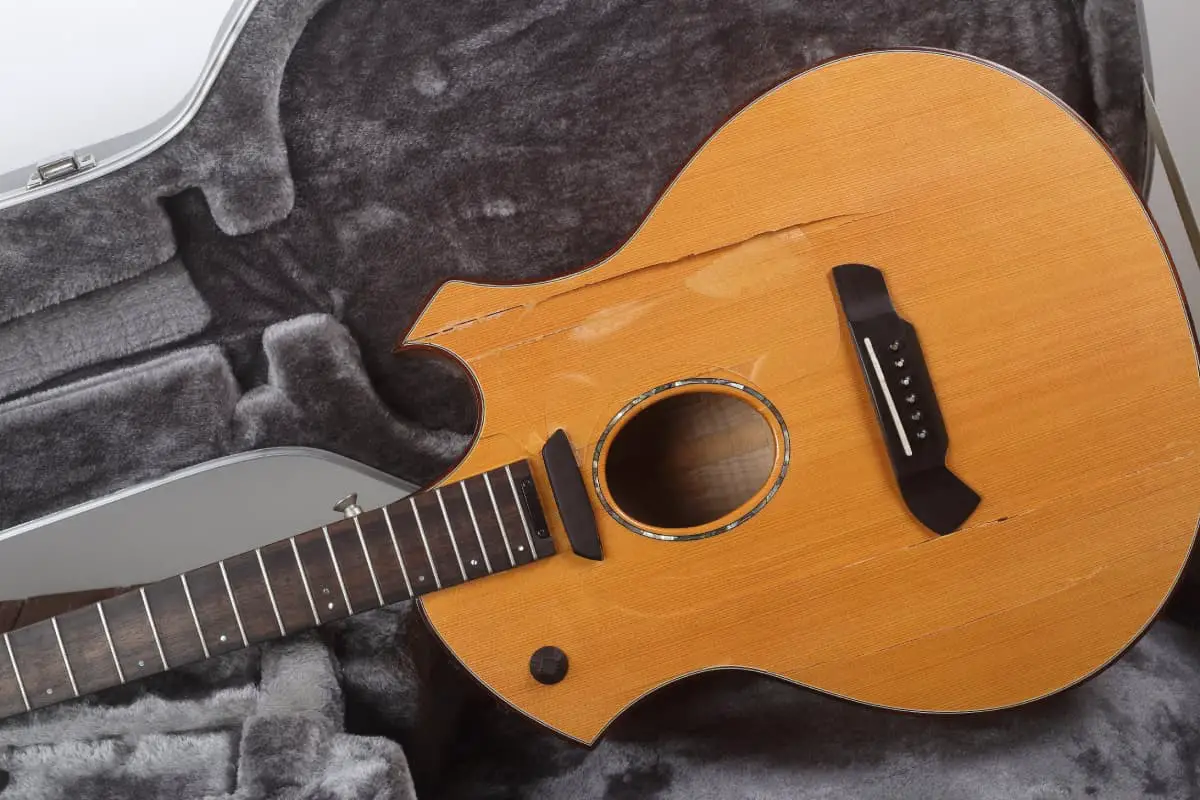Anyone who is a musician will tell you that their instrument is their most-prized possession, so it can often be devastating when something terrible happens to it. When speaking specifically about guitars, one of the worst things that can occur is when the wood of the guitar begins to crack. Thankfully, there are some precautions you can take to ensure that this does not happen to your guitar.
Here are five methods that can be used to keep your guitar from cracking:
- Do not leave the guitar anywhere that is too hot and dry.
- Monitor the humidity of the guitar’s location.
- Do not put the guitar through extreme temperature changes.
- Keep the guitar in a protective covering.
- Ensure that the guitar has a correctly-installed pickguard.
This article will break down these methods into further steps that can be taken to prevent any damage from happening to your guitar. It will also explain why cracks may occur and what to do if they happen.
👇😀👇NOTE👇😀👇
If you want to find out what my recommended guitar gear is, then here is what I recommend on Amazon:
- Fender Cutaway Acoustic-Electric Guitar Bundle (MY FAVORITE GUITAR)
- Snark SN-8 Super Tight All Instrument Tuner (Easiest Tuner I’ve Used😏)
- 6 String Acoustic Guitar Capo (Best CAPO for quick changes)
- Dunlop Max Grip 1.0mm Nylon Picks (Thick Guitar Pick So You Don’t Lose Grip!)
- Universal Guitar Stand (Cheap & Minimalist Guitar Stand I Recommend)
- Levy’s 2″ Wide Quick Adjust Guitar Strap (Best Guitar Strap For Any Level)
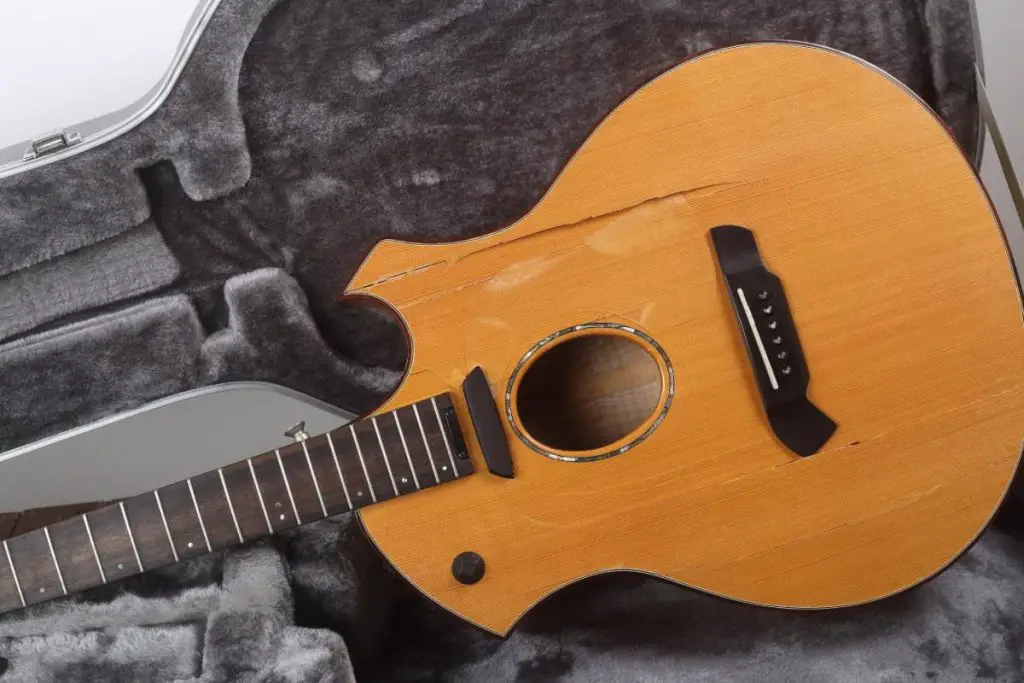
How Cracks in Guitars Happen
Even if you are treating your guitar extremely carefully, there is always the possibility that a crack could seemingly appear out of nowhere in the wood of the body. While this may be a distressing phenomenon, it is important to consider how the break happened because it will give you a better idea of how to prevent it from occurring going forward.
There are really only three main situations that can happen that can cause a guitar to crack, and luckily all of them are preventable if the proper measures are taken.
A Lack of Humidity
The most common reason for a guitar to begin showing cracks is that it is being kept in an area that is too dry and is not exposed to enough humidity on a consistent basis.
Just like any other object made out of wood, the body of a guitar can expand and contract depending on the environment in which it is kept. The wood of the instrument will shrink if it becomes too dry, and when it can no longer stretch in its frame, it can crack.
This type of break typically runs along the grain of the wood on the top of the guitar. Sometimes, the separation in the top can be as much as 10 to 15 thousandths of an inch (0.254mm to 0.381mm). While this sounds like an extremely small amount, it can be detrimental to the instrument if the proper measures are not taken to care for it.
Impact Cracks
Another possible instance where a guitar may begin to break apart is when the guitar takes a substantial hit against something hard and begins to split.
These types of cracks from impact typically are not open and do not separate the actual wood of the instrument. The wood will most likely break along the grain of the guitar as a humidity crack would, but it should not split apart unless you really smack it against a hard surface or a heavy object is dropped on it.
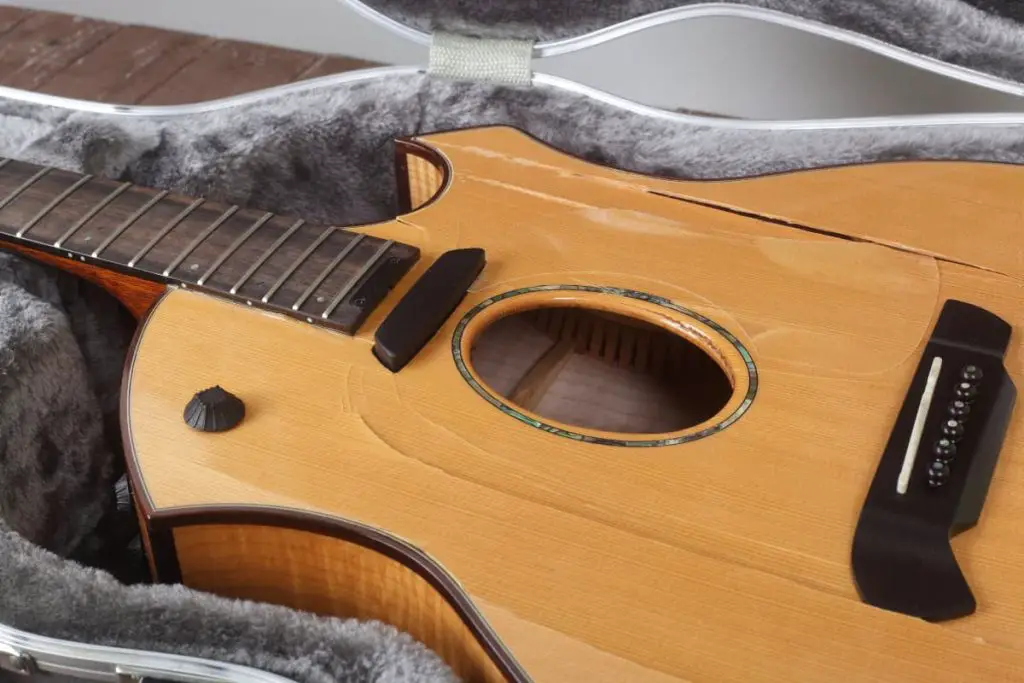
The Pickguard Is Installed Incorrectly
There is a third possible reason that a guitar could start to break apart, and that is if the pickguard on the guitar is not installed correctly.
If the placement of the guard is poorly done, it will begin to exert stress on the body of the guitar. The longer the pickguard stays this way while being played, the higher chance there is that the shell of the guitar could crack.
This is the most unlikely scenario since most guitars are built perfectly fine and will not have a pickguard that is out of place or built onto the guitar incorrectly. When purchasing your instrument, be sure to check that the pickguard is appropriately installed before you leave the store.
Five Methods To Keep Your Guitar From Cracking
Preventing your guitar from cracking is actually relatively straightforward when the right measures are adhered to. The steps that should be taken to keep breaks from occurring are ones that can be done by anyone in any location.
1. Do Not Leave the Guitar Anywhere That Is Too Hot and Dry
Because one of the primary reasons that guitars crack is a lack of moisture in the air, it makes sense that leaving your instrument in a place that has a hot, arid climate could cause it to break.
A crack from low humidity is much more likely to occur if you live in a dry area, but it can still happen in locations that are humid, depending on the season and the temperature outside. During the wintertime, there is a much higher chance of this happening because people naturally turn on their heat, and the house becomes too dry for the guitar to handle.
One way to prevent a guitar from drying out and separating is to keep a guitar humidifier in the case where the instrument is kept. A guitar humidifier like D’Addario Accessories Acoustic Guitar (available on Amazon.com) is essentially a small sponge that sits inside a plastic container. The container rests inside the soundhole in the body of the instrument, where it is suspended by the guitar strings.
When the sponge is soaked in water and the container is closed up, the wetted sponge will help to release moisture into the air inside the case. It will not provide an extensive amount of humidity, but it will keep the immediate area the guitar is in from becoming too dry and help stop cracking from happening.
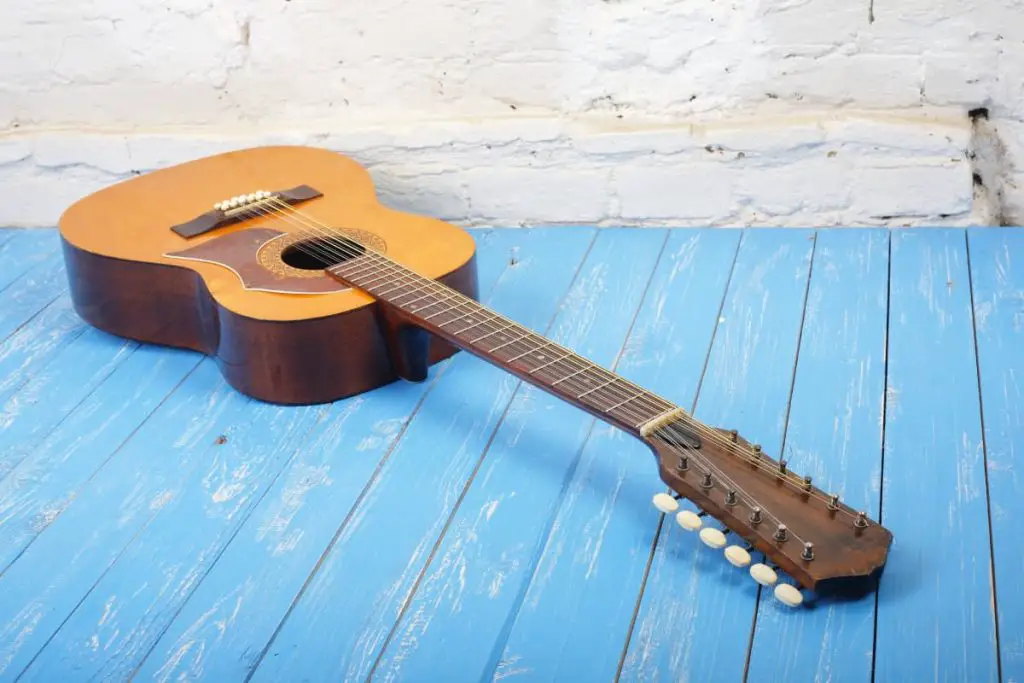
2. Monitor the Humidity of the Guitar’s Location
While it is essential that your guitar stays in an area where there is plenty of moisture in the air, it is also crucial for you to check the humidity levels in that area from time to time.
Wooden guitars should ideally be stored inside of a case in a room where the relative humidity is between 40% and 55%. The optimal percentage of moisture to keep a guitar from breaking is 50%, but as long as it does not go below 40% or exceed 55%, it will be much safer from cracks due to dryness.
The best way to monitor the humidity in the space where your guitar is kept is to use a hygrometer like the DWEPTU Digital Hygrometer Thermometer (available on Amazon.com). This is a device that can tell you the relative humidity levels of the area in which it is located.
Having a hygrometer available to read the moisture percentage in the room will help with both under-hydration and overhydration. If the product is small enough, you may even be able to keep one inside your guitar case to be absolutely sure that it is staying at an appropriate humidity level.
Keeping your guitar in a place that experiences a large amount of humidity regularly can also be damaging to the wood because it can cause it to warp. If leaving your guitar in a humid area is the only option you have, getting a dehumidifier for the room in which the guitar is kept is important.
3. Do Not Put the Guitar Through Extreme Temperature Changes
Taking your guitar from one climate to another very quickly is not something that often happens for everyone. Most guitar players will keep their guitar in one place the majority of the time, pull it out when they want to use it, and put it back in its spot when they are finished with it.
However, if you are someone who travels around a lot for performances, your guitar could be exposed to very different environments within short periods of time.
Bringing a guitar back and forth between warm and cold areas is one way that a crack could form on the body of the instrument. The abrupt temperature changes are enough to shrink and stretch the wood, and the guitar could ultimately end up splitting if it happens too many times.
In order to prevent this from happening, keep the guitar in a high-quality case when moving it from climate to climate, and do not take it out of its case right away after transporting it.
Keeping it in its case will help prevent the guitar from being exposed to the elements, which could cause breakage. Leaving it in its case for a while after arriving will allow the guitar time to adjust to its new environment slowly.

4. Keep the Guitar in a Protective Covering
Another reason why it is a good idea to keep your guitar in a case or trunk when you are not using it is to prevent it from hitting or being hit by anything.
If a guitar smacks into a hard surface with enough force, the impact can cause the wood to crack. Sometimes accidents just happen, but this can largely be prevented by transporting and leaving your guitar in a sturdy covering when it is not in use.
There are two potential guitar case options that you can use to keep your guitar from bumping into hard objects or bouncing around in the trunk of your car while traveling from place to place.
Soft Cases
Soft guitar cases, or gig bags, are best for keeping your guitar protected while carrying it hands-free, either on your shoulder or over your back like a knapsack.
Just because they are called “soft cases” and are made of thinner materials like nylon and polyester does not mean that they will not keep your guitar safe. There are a lot of gig bag options, like this Faswin 41 Inch Acoustic Guitar Bag (available on Amazon.com), that will keep your guitar from any impact while carrying it or while transporting it short distances.
One downside of the soft guitar case is that it does not do a great job of protecting the instrument from intense temperature changes. If your guitar is going to be moved from hot to cold environments often, a hard case may be a better choice.
Hard Cases
Based solely on the name, it is fair to assume that hard guitar cases are going to be much sturdier and more robust than soft gig bags. They are certainly bulky and more difficult to transport but will do a much better job of keeping your guitar from hitting something and cracking.
One benefit of a hard case is that although the outside of the case is made of solid materials like wood, plastic, fiberglass, and metal, the inside is soft and lined with a padded material.
This inner lining of fabric gives your instrument extra protection from being knocked around and potentially broken, while the outer layer takes most of the heavy-hitting. The plush material inside will also lock in humidity so that your guitar does not dry out and crack that way.
There are two main kinds of hard cases, those that are hardshell and made of wood and those that are made of carbon fiber and plastics and are molded to fit around the guitar.
Hardshell wooden cases, like this Gator Cases Hard-Shell Wood Case (available on Amazon.com), are the type of case you would want to use when traveling short distances with your instrument. If you are physically carrying your guitar from gig to gig or are taking it in the car, these cases are perfectly suitable and protective.
Molded cases made of manufactured plastic blends, like this Gator Guitar Case (available on Amazon.com), are the other option when it comes to a hardshell case. These cases are going to be your best bet for keeping your guitar safe when traveling by other means of transport like airplane or train.
No matter what type of case you end up deciding to purchase for your guitar, the most essential aspect of the product is that it will keep your guitar from cracking due to lack of humidity or strong impact.
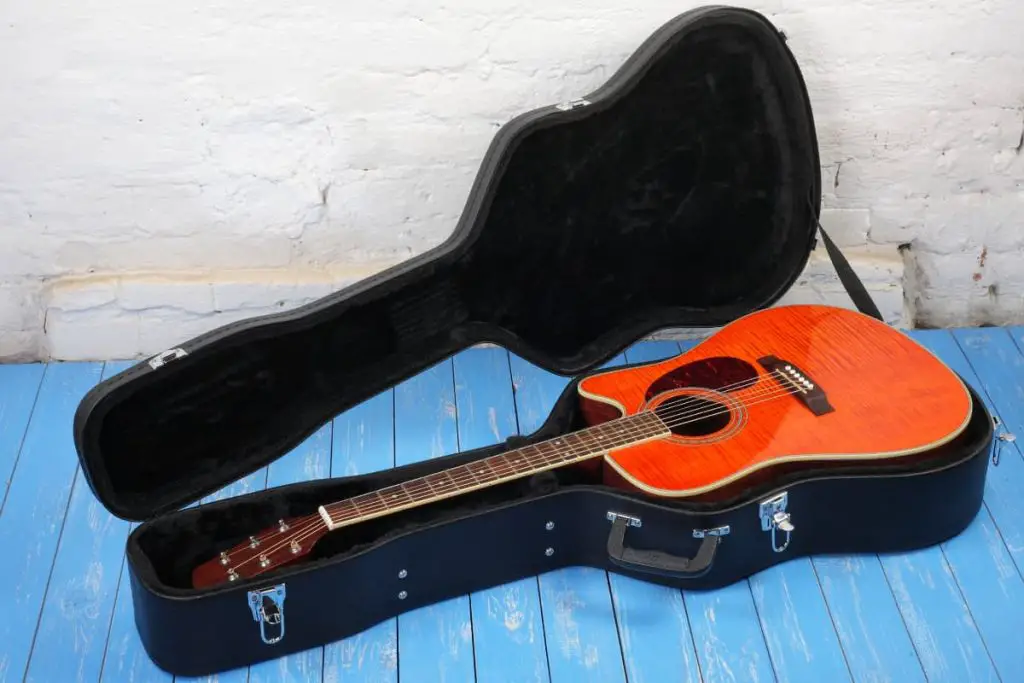
5. Ensure That the Guitar Has a Correctly-Installed Pickguard
The last precaution that can be taken to prevent cracks from happening in your guitar is to check that the pickguard was properly placed and has not shifted out of its designated spot.
Because of the amount of use the pickguard gets when playing your instrument, if it is slightly off or is not set into the guitar the right way, the body of the guitar will have too much pressure on it.
Cracks are much more likely to appear in this instance, and this type of crack can be detrimental to the guitar. Ensuring that the pickguard is in its correct place and is tightly secured every time you take out your guitar to play will help to keep those breaks from happening unnecessarily.
What To Do if Your Guitar Cracks
If you do end up in the unfortunate situation of your guitar cracking, there are a few steps you should take to prevent further damage to the instrument:
1. Do Not Touch the Crack
It can certainly be tempting to want to examine the break and try to figure out what happened, but feeling the spot where it cracked is not a wise decision. Touching the area will only work dirt and oil from your fingers into the crack, which will make it much more challenging to put back together.
2. Look at the Crack and Assess the Damage
Any crack is serious, but if the guitar broke all the way through the wood, it is going to need a much more intensive repair process.
Almost all cracks in the wood of a guitar happen along the grain of the wood. They are much more likely to occur on the top of the guitar as well, which can be a significant problem.
The wood that makes up the top of the guitar is often a softer, more delicate wood than the rest of the body. A crack in this wood has the potential to drastically change the way the guitar sounds, and not for the better.
3. Remove the String Tension
Remove the string tension to make closing the crack easier and getting the guitar fixed as soon as you possibly can. The longer the break sits open, the more difficult it will be for the repair person to fix it seamlessly.
It is definitely not recommended to attempt to fix the crack yourself. It is a highly meticulous process that takes a delicate hand and years of experience.
While you may be able to bind the separation in the wood temporarily, it likely will not stay put and could end up damaging the guitar even further. Instead, find a trustworthy source at a guitar shop who has knowledge about fixing cracks and will do it correctly.
Final Thoughts
The causes of cracking and methods to prevent it listed above are going to be your best bet when troubleshooting what might have happened, how to fix it now, and how to keep it from happening in the future. Accidents do happen even if you are incredibly careful with your instrument, but as long as you follow these steps, your guitar should stay in excellent condition.
👇😀👇NOTE👇😀👇
If you want to find out what my recommended guitar gear is, then here is what I recommend on Amazon:
- Fender Cutaway Acoustic-Electric Guitar Bundle (MY FAVORITE GUITAR)
- Snark SN-8 Super Tight All Instrument Tuner (Easiest Tuner I’ve Used😏)
- 6 String Acoustic Guitar Capo (Best CAPO for quick changes)
- Dunlop Max Grip 1.0mm Nylon Picks (Thick Guitar Pick So You Don’t Lose Grip!)
- Universal Guitar Stand (Cheap & Minimalist Guitar Stand I Recommend)
- Levy’s 2″ Wide Quick Adjust Guitar Strap (Best Guitar Strap For Any Level)

